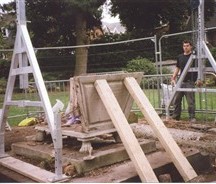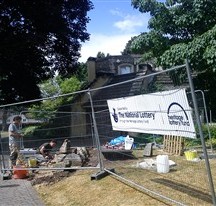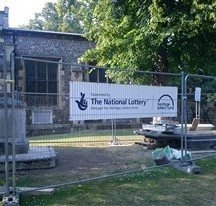St Mary's Churchyard Tombs Restoration Project
Repairing 13 historic memorials
by the Watford Museum Team
In 2013 Watford Borough Council was awarded a grant by the Heritage Lottery Fund towards restoring a number of tombs in the churchyard of St Mary’s in Watford High Street. The project included repairs to 13 locally and nationally listed tombs belonging to key people who helped shape the development of Watford during the eighteenth and nineteenth centuries. These include the Dyson family, founders of the brewery which evolved into the Benskins brewery; the Clutterbuck family, one of whom wrote the “History of Hertfordshire”, and the Finch family who were associated with Frogmore House. You can read about each of these tomb stones and their restoration on this website.
The project was a collaborative one between Watford Borough Council Planning Department, Watford Museum and a number of local groups and organisations. It also enabled a range of educational events and family activities to take place allowing the whole community to get involved in the project.
State of Decay
The primary methods of decay for churchyard monuments are vegetation, subsidence and decaying iron fixings widely used as structural ties in the monuments. Ivy and other types of creepers can overtake entire monuments and as growth occurs push sections apart and cause damage to footings and foundations.
The typical characteristics of a graveyards, often incorporating large underground caverns, leave the grounds very susceptible to movement and subsidence and can cause side panels to twist and warp and joints to weaken. The monuments’ iron fixings decay overtime as they are exposed to changes in weather and temperature and as they rust and corrode they expand, placing huge amounts of pressure on joints and in some cases cause areas of stone to crack and separate.
The Restoration Works
Any conservation or restoration treatment includes a thorough examination of the object(s) and a condition report is produced highlighting the main problems and concerns and making recommendations for treatment. The team from Sally Strachey Historic Conservation who undertook the work used the following processes for the restoration of the St Mary’s Tombs:
- Removal of damaging vegetation
- Dismantling of unsafe structures
- Removal of all iron fixings
- Rebuilding on firm footings
- Installing new core material
- Rebuilding the monument with stainless steel fixings
- Careful cleaning of surfaces
- Repairing surface detail with lime mortars to improve legibility
- Re-pointing with lime mortars, in some cases adding a final protective lime shelter-coat.
Great care and attention to detail is needed throughout, particularly where monuments are being dismantled and rebuilt.
Further information on the decay of tombs can be read in Sally Strachey’s article Churchyard Monuments.
St Mary’s Conservation Area
Now that the tombs have been restored they are to be included in an ongoing upkeep and maintenance plan to ensure their continued future and ensure they do not fall into disrepair again. It is also hoped that the St Mary’s Conservation area will soon gain Green Flag status.
The stone memorials will be cleaned using materials and techniques recommended by the specialist conservators who carried out the restoration work. This will include the use of water and soft bristle brushes for cleaning, no metal brushes, chemicals or high-pressure water jets are to be used. The general surrounding area is to be up-kept on a regular basis, during which the new drains will be checked and debris removed and vegetation approaching the tombs will be pruned. The surrounding ground levels will be surveyed and monitored to ensure the monuments stability.
New signage has been installed in the graveyard to aid in the identification of each of the tombs and provide visitors with more information. A leaflet summarising the project and information about the tombs has also been produced.






No Comments
Add a comment about this page